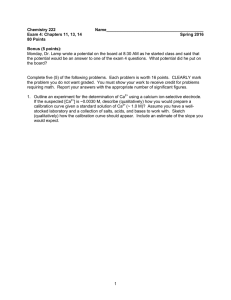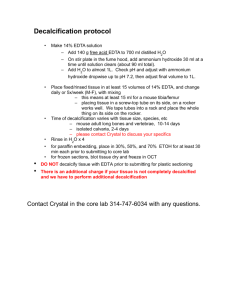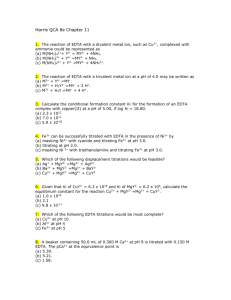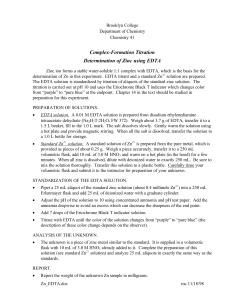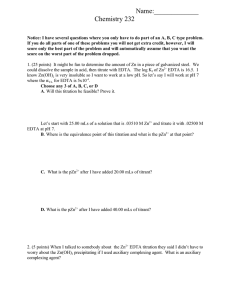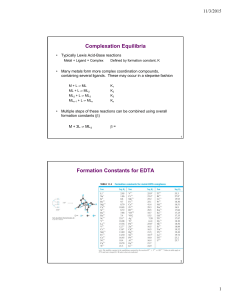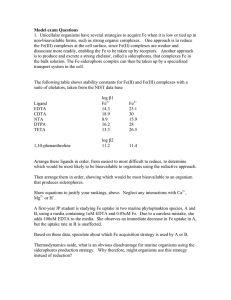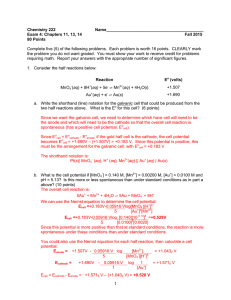Chemistry 222 Name__________________________________________ Exam 4: Chapters 11, 13, 14
advertisement
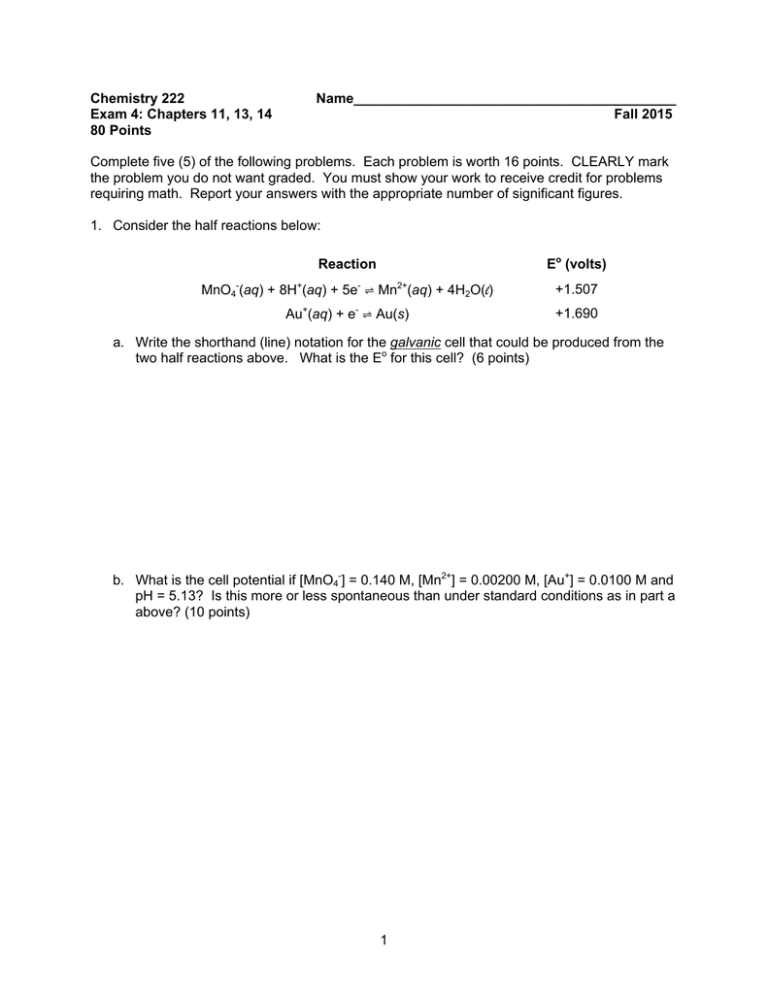
Chemistry 222 Exam 4: Chapters 11, 13, 14 80 Points Name__________________________________________ Fall 2015 Complete five (5) of the following problems. Each problem is worth 16 points. CLEARLY mark the problem you do not want graded. You must show your work to receive credit for problems requiring math. Report your answers with the appropriate number of significant figures. 1. Consider the half reactions below: Reaction Eo (volts) MnO4-(aq) + 8H+(aq) + 5e- ⇌ Mn2+(aq) + 4H2O(l) +1.507 Au+(aq) + e- ⇌ Au(s) +1.690 a. Write the shorthand (line) notation for the galvanic cell that could be produced from the two half reactions above. What is the Eo for this cell? (6 points) b. What is the cell potential if [MnO4-] = 0.140 M, [Mn2+] = 0.00200 M, [Au+] = 0.0100 M and pH = 5.13? Is this more or less spontaneous than under standard conditions as in part a above? (10 points) 1 2. Consider the titration of 20.0 mL of 0.0200 M Fe(NO3)2 with 0.0100 M EDTA in a solution buffered at pH 8.00. (log Kf = 14.30 for the Fe2+-EDTA complex) a. Calculate pFe2+ at two of the volumes below. (12 points) At the equivalence point 11.2 mL before the equivalence point 11.2 mL after the equivalence point. b. Given that the fraction of the EDTA present as Y4- does not reach its maximum until pH is over 12 or so, why would we choose to run the titration at pH 8.00 instead? (4 points) 2 3. You need to do a pH measurement and have a pH electrode, pH 4.00, 7.00, and 10.00 buffers, but no pH meter! You do, however, have access to a voltmeter capable of measuring potential differences at the millivolt level. Using these materials, describe how you could determine the pH of an unknown aqueous solution. Include a description of how you would collect the data and how you would use the data to find the pH of your unknown. 3 4. In our magnesium determination in the laboratory, we added a solution made from ammonia and ammonium chloride to each sample prior to titrating with EDTA. Explain the two primary purposes served by the addition of this solution? 4 5. Calculate the E at pH 11.00 for the half reaction Pd(OH)2 (s) + 2e- ⇌ Pd (s) + 2OH- given that the Ksp for Pd(OH)2 is 3.0x10-28 and the Eo = +0.915 V for Pd2+ + 2e- ⇌ Pd (s). 5 6. A 1.25 g sample of soil containing Cu2+ and Zn2+ and other nonmetals was digested in acid and diluted to a final volume of 50.00 mL. This solution was treated with 25.0 mL of 0.0452 M EDTA to bind all the metal. The excess unreacted EDTA required 12.4 mL of 0.0123 M Mg2+ for complete reaction. An excess of the reagent 2,3-dimercapto-1-propanol was then added to displace the EDTA from zinc only. Another 29.2 mL of Mg2+ were required for reaction with the liberated EDTA. Calculate the percent by weight of Cu2+ and percent by weight of Zn2+ in the original rock sample. 6 Possibly Useful Information Kw = 1.0 x 1014 = [H+][OH-] E Eo x 2.303RT 0.05916V log Q Eo log Q nF n b b 2 4ac 2a Go = -nFEo = -RTlnK F = 96485 C mol-1 R = 8.31441 Jmol-1K-1 0.05916V E const. log ion n m y = mx + b , y x Values of y4- for EDTA at 20°C and = 0.10 M pH y4- y4- pH pH y4- 3.7 x 10 -7 10 0.36 -5 11 0.85 1.3 x 10 -23 1 1.9 x 10 -18 6 2.3 x 10 2 3.3 x 10-14 7 5.0 x 10-4 12 0.98 3 2.6 x 10-11 8 5.6 x 10-3 13 1.00 4 -9 9 -2 14 1.00 0 3.8 x 10 5 5.4 x 10 7



